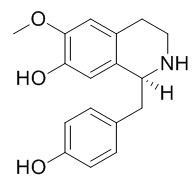Coclaurine
(+)-R-Coclaurine and (+)-S-reticuline show negative inotropic effects, coclaurine derivatives and of paeoniflorin derivatives have neuromuscular blocking actions. D-Coclaurine has a neuroleptic-like property in blocking effects of dopaminergic stimulating agents.
Inquire / Order:
manager@chemfaces.com
Technical Inquiries:
service@chemfaces.com
Tel:
+86-27-84237783
Fax:
+86-27-84254680
Address:
1 Building, No. 83, CheCheng Rd., Wuhan Economic and Technological Development Zone, Wuhan, Hubei 430056, PRC
Providing storage is as stated on the product vial and the vial is kept tightly sealed, the product can be stored for up to
24 months(2-8C).
Wherever possible, you should prepare and use solutions on the same day. However, if you need to make up stock solutions in advance, we recommend that you store the solution as aliquots in tightly sealed vials at -20C. Generally, these will be useable for up to two weeks. Before use, and prior to opening the vial we recommend that you allow your product to equilibrate to room temperature for at least 1 hour.
Need more advice on solubility, usage and handling? Please email to: service@chemfaces.com
The packaging of the product may have turned upside down during transportation, resulting in the natural compounds adhering to the neck or cap of the vial. take the vial out of its packaging and gently shake to let the compounds fall to the bottom of the vial. for liquid products, centrifuge at 200-500 RPM to gather the liquid at the bottom of the vial. try to avoid loss or contamination during handling.
Bioorg Chem.2024, 145:107184.
J of Food Quality2020, 8851285.
Clin Transl Med.2021, 11(5):e392.
J Liq Chromatogr R T2025, 2505536.
Applied Biological Chemistry 2021, 64(75)
Pol J Microbiol.2021, 70(1):117-130.
Antioxidants (Basel).2020, 9(6):526.
Front Pharmacol.2021, 12:635510.
Environ Toxicol.2023, 38(5):1174-1184.
Molecules.2024, 29(5):1171.
Related and Featured Products
Jpn J Pharmacol. 1989 May;50(1):75-8.
Inotropic effects of (+/-)-higenamine and its chemically related components, (+)-R-coclaurine and (+)-S-reticuline, contained in the traditional sino-Japanese medicines [Pubmed:
2724702]
(+/-)-Higenamine (Hig. demethylCoclaurine) is a cardiotonic principle from aconite root. (+)-R-Coclaurine (Coc) and (+)-S-reticuline (Ret) are compounds contained in the dried buds of Magnolia salicifolia MAXIM.
METHODS AND RESULTS:
All of these alkaloids possess a common chemical structure: tetrahydroisoquinoline. Coc and Ret showed negative inotropic effects in contrast to the positive inotropic effects of Hig in papillary muscles of guinea pigs. Coc and Ret shifted to the right the concentration-contraction curves of Hig. Hig shifted in parallel to the left the Ca2+ curve, and it tended to shift to the left the isoproterenol (Isp)-induced response curve. In contrast, Coc and Ret inhibited the Ca2+ curve and the low concentration range of the Isp-induced curve, and it potentiated the high concentration ranges of Ca2+ and Isp.
CONCLUSIONS:
Coc and Ret showed actions that were reversed in direction to those of Hig, as clearly demonstrated in the Ca2+ curve.
Planta Med. 1982 Jul;45(3):136.
The neuromuscular blocking actions of coclaurine derivatives and of paeoniflorin derivatives.[Pubmed:
17396817 ]
METHODS AND RESULTS:
The neuromuscular blocking actions of Coclaurine derivatives and of paeoniflorin derivatives.
J Pharmacobiodyn. 1983 Oct;6(10):793-6.
Effects of d-coclaurine and d-reticuline, benzyltetrahydroisoquinoline alkaloids, on levels of 3,4-dihydroxyphenylacetic acid and homovanillic acid in the mouse striatum.[Pubmed:
6141236]
METHODS AND RESULTS:
An intracerebroventricular injection of d-Coclaurine (50 micrograms), a benzyltetrahydroisoquinoline alkaloid extracted from Magnolia salicifolia, produced a slight increase in 3,4-dihydroxyphenylacetic acid level and a significant increase in homovanillic acid level in the mouse striatum. Another alkaloid d-reticuline (200 micrograms) increased only homovanillic acid level. An intracerebroventricular pretreatment with d-Coclaurine (50 micrograms) did not antagonize suppressive effect of apomorphine on l-dopa formation produced by gamma-butyrolactone (750 mg/kg i.p.) plus aromatic amino acid decarboxylase inhibitor, NSD-1015 (100 mg/kg i.p.).
CONCLUSIONS:
These results suggest that d-Coclaurine blocks postsynaptic but not presynaptic dopamine receptors in the mouse striatum.
Phytochemistry. 2001 Apr;56(7):649-55.
Purification and characterization of coclaurine N-methyltransferase from cultured Coptis japonica cells.[Pubmed:
11314949]
METHODS AND RESULTS:
S-Adenosyl-L-methionine (SAM): Coclaurine N-methyltransferase (CNMT), which catalyzes the transfer of a methyl group from S-adenosyl-L-methionine to the amino group of the tetrahydrobenzylisoquinoline alkaloid Coclaurine. was purified 340-fold from Coptis japonica cells in 1% yield to give an almost homogeneous protein.
CONCLUSIONS:
The purified enzyme, which occurred as a homotetramer with a native Mr of 160 kDa (gel-filtration chromatography) and a subunit Mr of 45 kDa (SDS-polyacrylamide gel electrophoresis), had an optimum pH of 7.0 and a pI of 4.2.
Whereas (R)-Coclaurine was the best substrate for enzyme activity, Coptis CNMT had broad substrate specificity and no stereospecificity CNMT methylated norlaudanosoline, 6,7-dimethoxyl-1,2,3,4-tetrahydroisoquinoline and 1-methyl-6,7-dihydroxy-1,2,3,4-tetrahydroisoquinoline.



